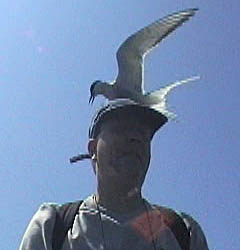 Last year my dwarf pampas grass flowered for the first time. Days later the stems were stripped. This year I found out why. The sparrows have been stripping them. Saw one removing one of the few the remaining flowers from an upstairs back window. When it flew off I went to the front of the house on a hunch and sure enough dad arrived with some more nest material!
Last year my dwarf pampas grass flowered for the first time. Days later the stems were stripped. This year I found out why. The sparrows have been stripping them. Saw one removing one of the few the remaining flowers from an upstairs back window. When it flew off I went to the front of the house on a hunch and sure enough dad arrived with some more nest material!
 Our squirrel is still coming, but refuses to use the squirrel feeder stacked with peanuts, preferring instead to trash the sunflower seed feeders.
Our squirrel is still coming, but refuses to use the squirrel feeder stacked with peanuts, preferring instead to trash the sunflower seed feeders. After the damselflies we finally had a dragonfly in the shape of this common darter........
After the damselflies we finally had a dragonfly in the shape of this common darter........ and there have been a range of other insects, spiders, bugs around............
and there have been a range of other insects, spiders, bugs around............
 a sloe bug
a sloe bug
 mullein moth caterpillar
mullein moth caterpillar

Misumena valia (crab spider)

Araniella curcurbitina
(actually this is an archive picture - but the one above reminded me
to dig it out because I like the colour contrasts!)
And finally we come to the red beetle/bug section. The next picture is rubbish but I wanted to include a snap of my red beetle public enemy number one. I'm generally fairly tolerant of garden pests, but when found I'm afraid this immigrant doesn't last long enough for decent photos to be taken!

Lily beetle
The next was an oddity which I think I've correctly identified, although I don't know exactly which member of the family it is. It was certainly quite striking.

Eurydema spp.
Lastly we come to a beetle I always knew as the soldier beetle. Apparently there's more than one type, but this is a soldier beetle, contrasting quite nicely with the blue sea holly.

Rhagonycha fulva
According to the recent Nature's Calendar series on t.v. they are known as bonking beetles, but it struck me that this must be a 'new' name - hardly something from folklore. According to the OED the use of 'bonk' to mean sexual intercourse was first recorded in 1975, so it must have taken a few years to reach beetles! That said the shots below from a couple of local venues do show how they got the name.
(Is it only me who struggles to tell one umbellifer from another?)















No comments:
Post a Comment